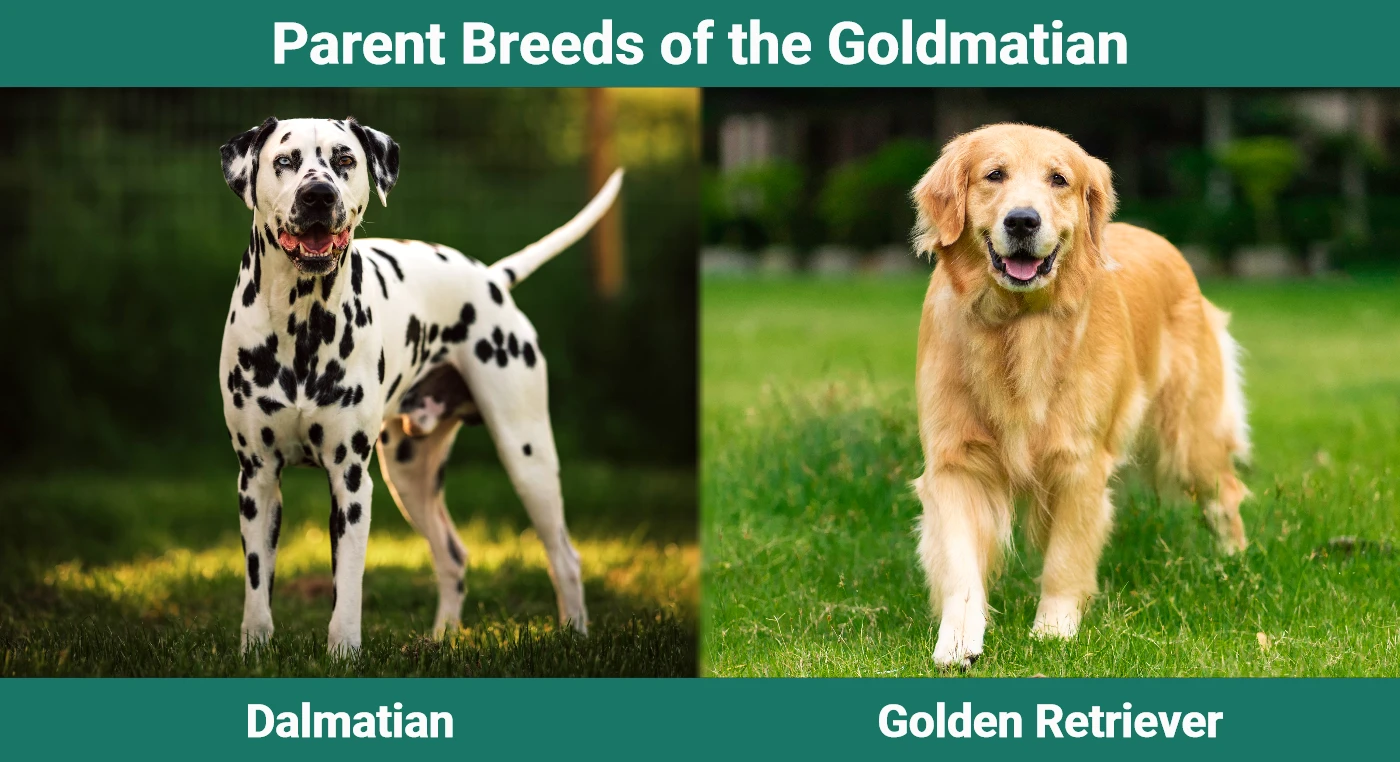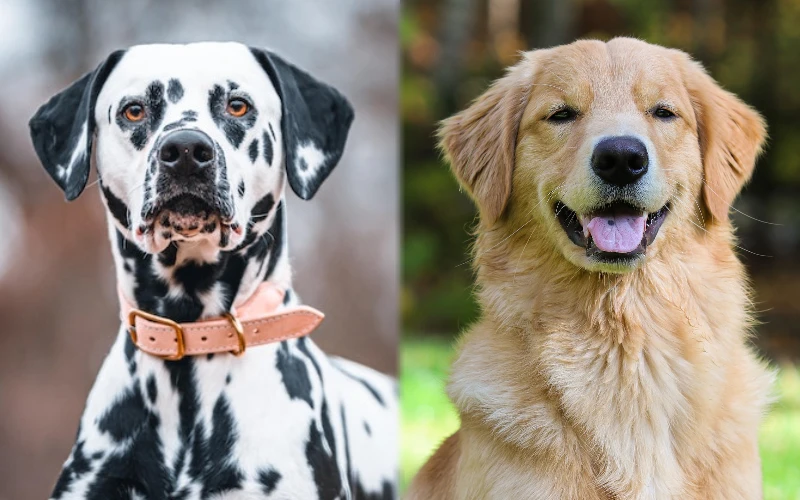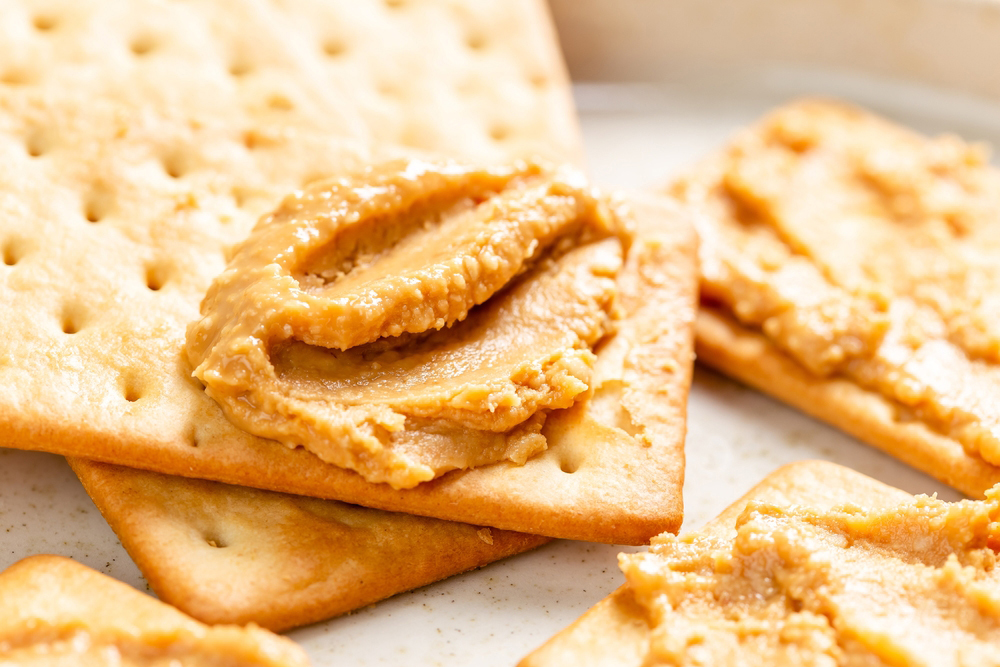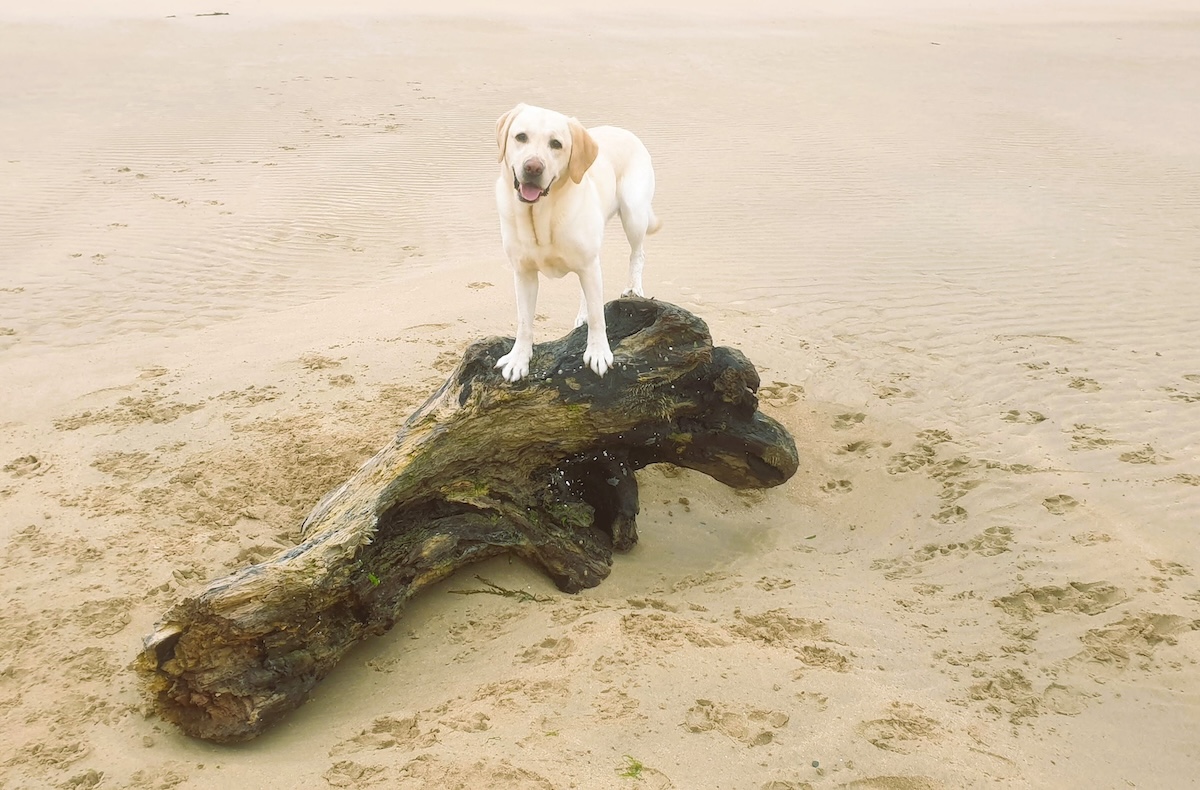Click Below to Skip Ahead
Goldmatians, or Goldmations, are the adorable result of a Golden Retriever and Dalmatian mix, an undeniably sweet, intelligent parentage. They are an excellent choice for single owners or families and can be trained to be watchdogs, but their lack of aggression means their bark will definitely be worse than their bite.
So, whether you’re here because you’re thinking of getting one of these beautiful dogs or want to learn a little bit more about them, keep reading because we have all the information you’ll need!
Breed Overview
Height:
19–23 inches
Weight:
55–70 pounds
Lifespan:
10–12 years
Colors:
Gold, black, pied
Suitable for:
Single people, families with children, active owners
Temperament:
Playful, intelligent, friendly
Goldmatians make ideal pets for active people because they need plenty of mental and physical stimulation to stay happy and healthy. If your lifestyle keeps you out of the house for long periods, a Goldmatian isn’t the dog for you; they shouldn’t be alone for long and thrive with human companionship. Overall, the dogs are gentle, kind, and loving.
Goldmatian Characteristics
Goldmatian Puppies
It can sometimes be a guessing game working out what you will get with a mixed breed. Much like their parents when they are puppies, Goldmatian puppies are energetic, fun-loving, and playful.
Finding a Goldmatian to adopt will be easier in regions where Dalmatians are common, but Golden Retrievers are one of the most popular breeds in the United States and aren’t in short supply! It’s essential when searching for a Goldmatian to find a reputable breeder. The breeder should be willing to take you on a tour to meet their dogs and verify the parents’ paperwork before the adoption.
Since Goldmatians are prone to some health problems, it’s a good idea to check the parent dogs’ veterinary records so you can be prepared for any inherited diseases before they crop up.

Temperament & Intelligence of the Goldmatian
The Goldmatian is loyal, loving, and friendly and is laid back if they get plenty of exercise. As puppies, they can be rambunctious, and they get their smarts from both parents and can be quite a handful. This intelligence can also make them tricky to train, especially if they have a stubborn streak, so you should start as soon as possible.
Goldmatians love being with their families; whether in the house, playing in the yard, or going for walks, they need human company. They can suffer from separation anxiety if they’re left alone too much and exhibit undesirable behaviors like excessive barking and destroying furniture, which can lead to depression.
Are These Dogs Good for Families?🏡
Goldmatians are excellent for families since they’re gentle and affectionate dogs. If you socialize them early, they are good around adults and children of all ages. However, they’re energetic canines that need an active owner or family to take care of them. Goldmatians, like Dalmatians, can be hesitant around strangers and may bark loudly at people they don’t know, but they’re not aggressive.
Does This Breed Get Along With Other Pets?🐶 😽
If they are adequately trained, Goldmatians get along well with other pets, but they have high prey drives and need proper training and socialization if you have smaller pets. You might also need to supervise them around pets like rabbits and rodents. They are playful dogs, so they do well with another dog in the house that they can play with. This will also prevent loneliness when you are out of the house.
Things to Know When Owning a Goldmatian
Food & Diet Requirements🦴
All that energy builds up quite the appetite, so you must pick a high-quality food appropriate for their life stage and energy level. A poor-quality diet full of fillers will fill up your dog without providing the nutritional benefits a high-quality one will.
The Goldmatian can be prone to joint problems, so they’ll need a good balance of food and exercise to ensure they don’t put on weight. Obesity puts further pressure on joints and hips. To ensure they don’t overeat, feed them around 3 cups of food daily and pick a high-protein formula. This amount should be divided into two or three meals.
Exercise🐕
Goldmatians need around 75 minutes of exercise daily to keep them out of trouble. At least half of their daily exercise should be focused on an intense activity. Since they are incredibly athletic, they will appreciate a wide range of activities such as playing fetch, long daily walks, swimming, hiking, running, or catching a frisbee at the dog park. If you are out in public, make sure they are on a leash if they don’t have great recall because of their high prey drive.
Training🦮
Training is best done after your Goldmatian has burnt off some energy so they can focus. They do well with obedience and agility training and are clever, motivated, and eager to please, but they can also be stubborn and grow bored with training if you don’t make it interesting enough. Make sure you keep training sessions short, so they don’t grow frustrated, and use positive reinforcement to motivate them.
Grooming ✂️
Since the Golden Retriever and Dalmatian are prone to shedding, it should be no surprise that the Goldmatian will shed quite a bit. They are also prone to drooling, so you might need to increase your cleaning routine. They will require brushing twice a week at the minimum, which you must increase during spring and fall.
Thanks to their active lifestyle and drooling, they can develop a pungent doggy odor, so ensure you pick a gentle shampoo that won’t dry out their skin. You might also consider placing a blanket over their bedding or places they like to lie down so it’s easy to remove and throw in the washing machine.
Additionally, you will need to take care of their nails, teeth, and ears. Ensure you clean their ears at least once a week with a soft cloth. Their nails must be clipped about once a month, while you should aim to brush your dog’s teeth twice a day or at least three times a week to keep them strong and healthy.
Health and Conditions❤️
Dalmatians are vulnerable to more health problems than Golden Retrievers, but the Goldmatians are susceptible to the same conditions as their parents. Reputable breeders screen their dogs for inherited diseases, and it’s vital to find a breeder that ensures their breeding stock is healthy.
- Allergies
- Deafness
- Entropion
- Thyroid problems
- Cancer
- Epilepsy
- Hip and elbow dysplasia
- Renal dysplasia
Male vs Female
Currently, there are no known significant differences between males and females. However, males tend to be slightly larger than their female counterparts. Neutering or spaying is also recommended to reduce the risk of certain cancers and hormone-driven behaviors like aggression or marking territory. We recommend speaking to your vet about when it’s best to schedule the procedure.
3 Little-Known Facts About the Goldmatian
1. Goldmatian Puppies Can Be Pricey
The price of a Goldmatian depends on a few factors, like the breeder’s reputation and how easy the dogs are to source. If your dog has show-quality parents, you should expect to pay around $3,000. However, Goldmatian puppies without prestigious parents can cost $300 to $900.
2. They Make Good Watchdogs
Goldmatians make excellent watchdogs because they are wary around strangers and will warn you with barks that someone they don’t know is approaching the house. This behavior is thanks to their Dalmatian side because the Golden Retriever is just too friendly to be a good watchdog!
3. The American Kennel Club Doesn’t Recognize Them Because They Aren’t Purebred, but Other Clubs Do.
The American Kennel Club (AKC) does not recognize the Goldmatian because they only recognize purebred dogs. However, the Goldmatian is recognized by the American Canine Hybrid Club (ACHC), the Designer Dogs Kennel Club (DDKC), the Designer Breed Registry (DBR), the Dog Registry of America, Inc. (DRA), and the International Designer Canine Registry (IDCR).
https://www.instagram.com/p/Cs-sPrtIc0q/?utm_source=ig_web_copy_link&igshid=MzRlODBiNWFlZA==
Final Thoughts
The Goldmatian is a fantastic choice for active families with or without kids and single owners. They are loyal, friendly, protective without being aggressive, and the ideal exercise companions. They might be slightly trickier to source than other breeds, but they are definitely worth the search. They get all the best traits of their amazing parents and make excellent pets.
Related Reads:
- Dalusky (Dalmatian & Husky Mix): Pictures, Guide, Info, & Care
- Great Dane Dalmatian Mix Info: Pictures, Temperament & Traits
Featured Image Credit: Left – Jozef Fehér, Pexels | Right – Shayna Douglas, Unsplash












